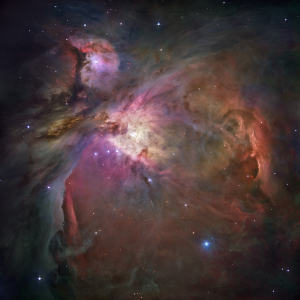2.6 Useful Measurements in Astronomy
In astronomy we deal with distances on a scale you may never have thought about before, with numbers larger than any you may have encountered. We adopt two approaches that make dealing with astronomical numbers a little bit easier. First, we use a system for writing large and small numbers called scientific notation (or sometimes powers-of-ten notation). This system is very appealing because it eliminates the many zeros that can seem overwhelming to the reader. In scientific notation, if you want to write a number such as [latex]500,000,000[/latex], you express it as [latex]5\times 10^8[/latex]. The small raised number after the [latex]10[/latex], called an exponent, keeps track of the number of places we had to move the decimal point to the left to convert [latex]500,000,000[/latex] to [latex]5[/latex]. The second way we try to keep numbers simple is to use a consistent set of units—the metric International System of Units, or SI (from the French Système International d’Unités).
A common unit astronomers use to describe distances in the universe is a light-year, which is the distance light travels during one year. Because light always travels at the same speed, and because its speed turns out to be the fastest possible speed in the universe, it makes a good standard for keeping track of distances. You might be confused because a “light-year” seems to imply that we are measuring time, but this mix-up of time and distance is common in everyday life as well. For example, when your friend asks where the movie theater is located, you might say “about [latex]20[/latex] minutes from downtown.”
So, how many kilometres are there in a light-year? Light travels at the amazing pace of [latex]3\times 10^5[/latex] kilometres per second (km/s), which makes a light-year [latex]9.46\times 10^{12}[/latex] kilometres. You might think that such a large unit would reach the nearest star easily, but the stars are far more remote than our imaginations might lead us to believe. Even the nearest star is [latex]4.3[/latex] light-years away—more than [latex]40[/latex] trillion kilometres. Other stars visible to the unaided eye are hundreds to thousands of light-years away as seen in Figure 2.1.
Orion Nebula

Hubble's Sharpest View of the Orion Nebula by NASA, ESA, M. Robberto (Space Telescope Science Institute/ESA) and the Hubble Space Telescope Orion Treasury Project Team, NASA Media Licence.
Attribution
“1.4 Numbers in Astronomy and Scientific Notation or Powers of Ten” and “A.5 Some Useful Constants for Astronomy” from Douglas College Astronomy 1105 by Douglas College Department of Physics and Astronomy, are licensed under a Creative Commons Attribution 4.0 International License, except where otherwise noted. Adapted from Astronomy 2e.

